I’ll admit right up front: tripods are awkward and they slow us down.
But sometimes they’re essential. Here are some tips for getting the
most out of them.
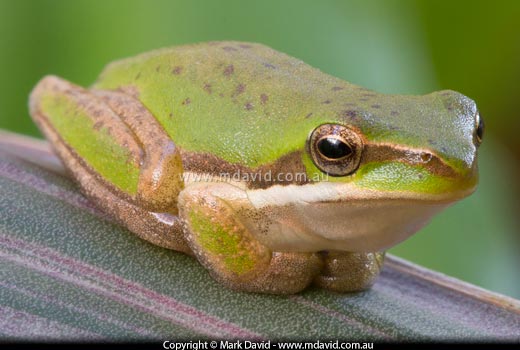
This tree frog was in very weak light. A tripod let me keep
the camera still during the long exposure I wanted.
Get a good one
I remember being amazed at how cheap and light my first tripod was. I remember then
being amazed at how bad it was. Even a mild breeze would cause the camera to wobble.
But I still have that tripod and it actually gets a fair bit of use. I just
don’t let it near a camera. Instead, I use it to hold other stuff, like props
or a flash. Eventually I bought a proper tripod and that’s the one I always use
now.
So if you plan on getting a tripod then plan on it being a good one. It needs to be
sturdy enough to easily hold your camera steady when it’s loaded up with your
heaviest lens, and that includes planning ahead for any future heavier lens you might
have in mind. When you realise that we tend to keep our tripods for a lot longer
than our cameras then you can think of it as a long-term investment.
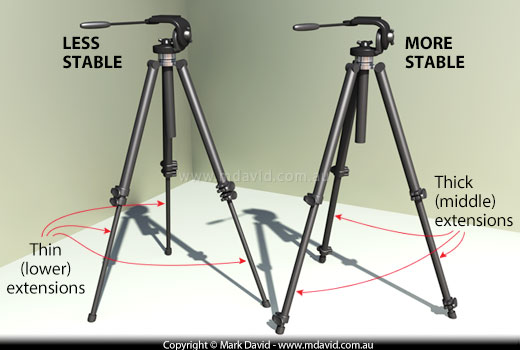
If you don’t need to extend your tripod’s legs
all the way, then using the thicker extensions will make the whole thing a little bit
more stable.
Extra stability
The way you extend the legs on your tripod affects how stable it is. If you only
need to use one set of extensions then use the thicker ones (the middle sections).
Because of their extra thickness it makes the whole structure just that little bit
more stable.
Working on a hill
The thing about tripods is that they’ll always have all three feet on the
ground. That is, until they topple over. So keep in mind the inherent strengths and
weaknesses of a triangle.
Tripods are at their most stable when they’re leaning against one of the legs
(a corner of the triangle), and at their least stable when they’re leaning against
one of the triangle’s sides. So when I have to perch my tripod on a hill, I like
to have one of the legs pointing down the hill. That way it has its greatest level of
protection against rolling down the hill with me chasing after it. You’ll need
to look at your particular circumstances and figure out for yourself what’s going
to be most stable of course, but that’s what I usually do. And if you need to
extend the centre post of the tripod upwards, try to ensure that it goes up rather than
at an angle, so that the weight of the camera is always over the top of the centre of
the triangle.
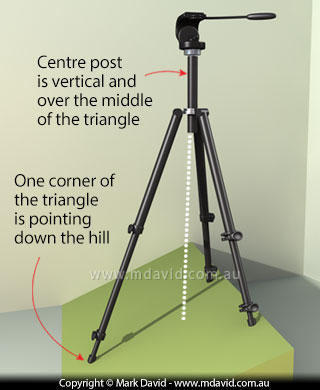
Here’s how I like to set up my tripod when I’m using
it on the side of a hill.

Mechanical (left) and electronic (right) cable release.
It used to be that the mechanical ones worked on pretty much everything but now you have
different makes and models of cameras requiring their own kinds of cable releases.
Grrr… So if you’re going to get one of these things make sure it’s
the right one for your camera.
Cable release
If I’m going to all the hassle of using a tripod, then I’ll often
use a cable release too. Especially if I’m doing macro
photography. Cable releases are things that allow you to have the shutter
button at the end of a cable with the other end of the cable plugged into the camera.
When you press the button, the vibrations fail to travel all the way down the
cable to the camera so it means your camera doesn’t jiggle. The combination of
cable release and tripod is the reason my photos of tiny frogs come out
tack-sharp. But don’t worry if you don’t have a cable release.
A delayed exposure (where you press the button and the exposure happens 10 seconds later)
will give your camera plenty of time to stop vibrating after you press that shutter button.
Image stabilisation
If your lens uses an image stabilisation system (or vibration reduction or whatever
your lens manufacturer calls it) then check the manual to see if it has a setting for use on
tripods. Because otherwise the image stabilisation system can become confused and cause
weird things to happen.
Macro focusing rails
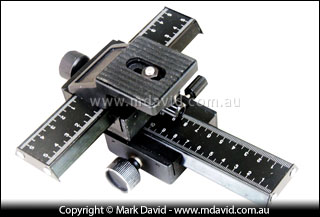
My trusty old macro focusing rail is mighty useful for precision
macro work.
I swear by these things. But only for macro photography because with any other kind
photography they are literally worse than useless. With a macro focusing rail you can
set up your tripod in something close to the right place, and then fine-tune the
camera’s position — horizontally and forwards/backwards — until
you’ve framed your image exactly how you want it. So like the name suggests,
they are brilliant for macro work, where a few millimetres of camera movement can
drastically change a photo’s composition. You can even use your focusing rail to
take a series of shots, one at a time, at different points along the horizontal rail.
Stitch the shots together in your image editing software and you have an macro panorama.
Or you can move the camera backwards/forwards in tiny increments to focus on different
parts of the scene for image stacking. Either way, the
focusing rail makes that kind of fiddly work heaps easier.
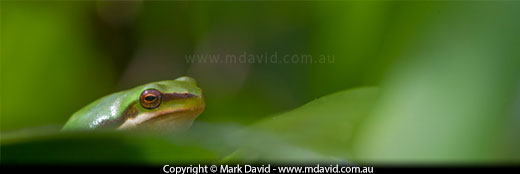
This macro panorama shot was created using the horizontal
adjustments in a macro focusing rail.
But I’ll stress again that if you’re not doing macro work then
don’t use a focusing rail. In regular photography that few millimetres
of a camera movement won’t make any difference. Even worse, it’s an extra
layer of clutter that could even be dangerous due to those focusing rails not being
designed to handle the weight of telephoto lenses.
Yeah, I know tripods are boring and clunky and inconvenient. But most professional
photographers have at least one decent tripod for the very simple reason that sometimes
they are extremely useful.

Making sense of technical stuff

Common problems and their solutions

Taking things further















